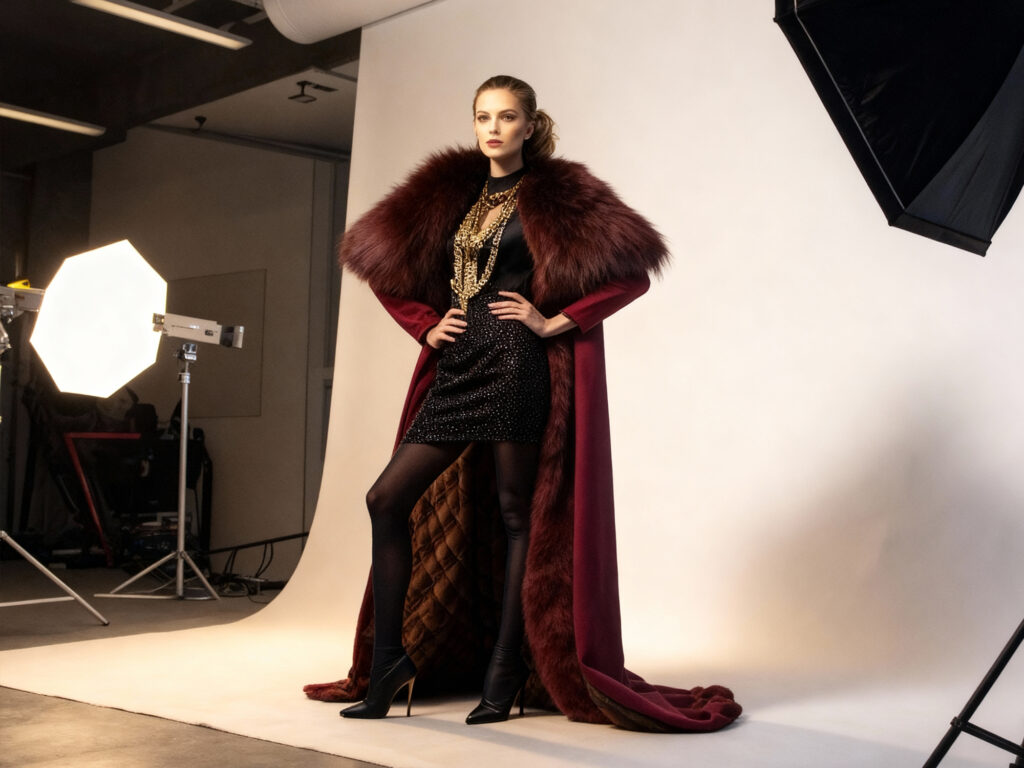Clothing and apparel brands come in all shapes and sizes. Each brand caters to a specific audience and fulfills unique consumer needs. Understanding the different types helps businesses position themselves strategically in the market.
Generally, clothing brands can be categorized by style, target audience, and price point including luxury, fast fashion, sustainable, and niche brands. Let’s explore how these brands are classified, the categories they belong to, and what makes each one stand out in today’s competitive fashion industry.
Table of Contents
What Are the Main Categories of Apparel?
Apparel is typically divided into three main categories based on purpose and use. These form the foundation of the clothing industry:

Luxury Fur-Trimmed Coat
Category | Description | Examples |
Casual Wear | Designed for everyday comfort and style. Ideal for relaxed or informal settings. | Jeans, T-shirts, hoodies |
Formal Wear | Tailored for professional, business, or ceremonial occasions where a polished look is required. | Suits, dresses, tuxedos |
Activewear | Focused on performance and functionality, providing comfort and flexibility during physical activities. | Gym clothes, leggings, running shoes |
Today, these categories often overlap due to the rise of [athleisure](https://www.fittdesign.com/blog/top-2024-activewear-trends), a blend of casual wear and activewear that combines comfort with style.
How Do You Classify Clothing Brands?
Clothing brands can be classified by their price range, target market, and design philosophy. These distinctions help define a brand’s position in the fashion landscape:
- Luxury Brands:Offer high-end materials, craftsmanship, and exclusivity (e.g., Gucci, Chanel).
- Premium Brands:Deliver quality and prestige at a more accessible price (e.g., Ralph Lauren, Tommy Hilfiger).
- Mid-Tier Brands:Provide balanced quality and affordability for the mass market (e.g., Levi’s, Uniqlo).
- Fast Fashion Brands:Focus on trendy, low-cost designs produced quickly (e.g., Zara, H&M).
Additionally, some brands emphasize sustainability or cultural identity, which further defines their niche and customer loyalty.
What Defines an Apparel Brand?
An apparel brand is more than just a company that makes clothes, it’s an identity, a story, and a promise. At its core, an apparel brand designs, manufactures, and markets clothing under a distinctive style and philosophy that connects with a specific audience.
While any company can produce garments, an apparel brand differentiates itself through design language, quality standards, and emotional appeal. It creates a recognizable image that resonates with consumers and builds loyalty over time.Key elements that define an apparel brand include:
Key Elements That Define an Apparel Brand
Element | Description | Examples |
Design Identity | Every apparel brand has a unique design philosophy reflected in its choice of fabrics, silhouettes, color palettes, and aesthetics. | Levi’s – timeless denimOff-White – streetwear meets luxury |
Brand Story and Values | A strong brand tells a story that communicates its vision, heritage, or core values such as sustainability, inclusivity, or craftsmanship. | Patagonia – sustainabilitySavage X Fenty – inclusivityHermès – craftsmanship |
Target Market | Each apparel brand is built around a specific audience segment, from luxury shoppers seeking exclusivity to younger consumers focused on affordability and trends. | Luxury, premium, fast fashion, or niche audiences |
Marketing and Visual Identity | Branding extends beyond products through consistent use of logos, typography, campaign tone, and collaborations that shape perception. | Influencer marketing, social media campaigns, logo design |
Emotional Connection | The strongest brands build emotional ties by representing a lifestyle or aspiration — making consumers feel part of something meaningful. | [Nike] (https://www.kubbco.com/blog/5-things-we-can-learn-from- nikes-brand-identity-and-advertising-strategy)– confidenceDior – eleganceUniqlo – comfort |
What Are the Key Clothing Segments in Fashion?
The clothing industry is vast and diverse, serving a wide range of consumers with different preferences, lifestyles, and body types. To meet these varied needs, clothing is often divided into segments based on audience, function, and style. Each segment represents a unique market opportunity with its own design approach and marketing strategy.
Major clothing segments:
Segment | Description | Examples |
Men’s Apparel | Focuses on style, functionality, and comfort for men. It ranges from casual wear and workwear to formal and activewear. | Shirts, jeans, suits, sportswear |
Women’s Apparel | The largest and most diverse segment, emphasizing both fashion and practicality. It evolves rapidly with trends and seasons. | Dresses, blouses, skirts, leggings |
Kids’ Apparel | Designed for children’s comfort, safety, and playful aesthetics. Durability and soft fabrics are key features. | T-shirts, shorts, school uniforms |
Unisex Apparel | Combines versatile designs suitable for all genders. Increasingly popular for its inclusivity and minimalist style. | Hoodies, T-shirts, sweatpants |
Plus-Size Apparel | Tailored for diverse body shapes and sizes, focusing on fit, confidence, and style inclusivity. | Plus-size dresses, jeans, outerwear |
Segments are expanding to promote inclusivity, featuring adaptive clothing that accommodates people with disabilities.
How to Categorize Different Types of Clothing?
Clothing items fall into five main categories: tops, bottoms, outerwear, accessories, and footwear. They can also be sorted by material, occasion, or season, making it easier to mix, match, and style outfits.
Breakdown of clothing categories:
Category | Examples |
Tops | T-shirts, blouses, sweaters |
Bottoms | Jeans, skirts, shorts |
Outerwear | Jackets, coats, blazers |
Accessories | Scarves, hats, belts |
Footwear | Sneakers, boots, sandals |
Further classifications, such as occasion (formal vs. casual) or seasonality (summer vs. winter), make shopping and production even more efficient.
Conclusion
Clothing and apparel brands are incredibly diverse, each serving distinct markets and purposes. From luxury houses to fast fashion powerhouses, every brand type plays a unique role in shaping the global fashion landscape. By understanding how apparel is categorized by style, audience, and price both consumers and businesses can make smarter decisions in this ever-evolving industry.
Lucy Cai
Hi, I’m Lucy Cai, the founder of liantaoapparel.com. I’ve been managing a women’s clothing factory in China for over 16 years. With extensive experience in garment production and OEM services, I’m passionate about sharing insights into women’s fashion, apparel manufacturing, and global sourcing.
